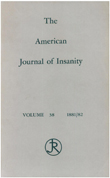Corticotropin-releasing hormone mRNA levels in the paraventricular nucleus of patients with Alzheimer's disease and depression
Abstract
OBJECTIVE: Greater activity of the hypothalamic-pituitary-adrenal (HPA) axis is associated with specific neurological and psychiatric disorders, including Alzheimer's disease and depression. Hyperactivation of paraventricular corticotropin-releasing hormone (CRH) neurons may form the basis of this increased activity of the HPA axis. METHOD: Activation of the CRH neurons was determined through measurement of the amount of CRH-mRNA in the paraventricular nucleus by using quantitative, in situ hybridization histochemistry with systematically sampled frontal sections through the hypothalamus of routinely formalin-fixed and paraffin-embedded autopsy brain material of 10 comparison subjects, 10 patients with Alzheimer's disease, and seven depressed patients. RESULTS: CRH-mRNA levels in the paraventricular nucleus of Alzheimer's patients were markedly higher than those of comparison subjects, whereas CRH-mRNA levels in the paraventricular nucleus of depressed patients were even higher than the levels of Alzheimer's patients. CONCLUSIONS: Paraventricular CRH neurons in Alzheimer's disease and depression are hyperactivated, and this hyperactivation may contribute to the etiology of these disorders.
Access content
To read the fulltext, please use one of the options below to sign in or purchase access.- Personal login
- Institutional Login
- Sign in via OpenAthens
- Register for access
-
Please login/register if you wish to pair your device and check access availability.
Not a subscriber?
PsychiatryOnline subscription options offer access to the DSM-5 library, books, journals, CME, and patient resources. This all-in-one virtual library provides psychiatrists and mental health professionals with key resources for diagnosis, treatment, research, and professional development.
Need more help? PsychiatryOnline Customer Service may be reached by emailing [email protected] or by calling 800-368-5777 (in the U.S.) or 703-907-7322 (outside the U.S.).



